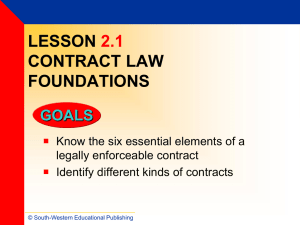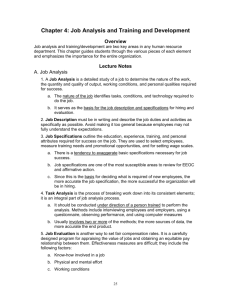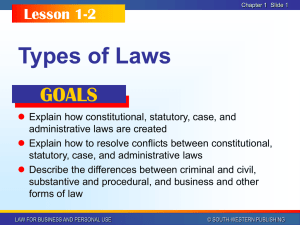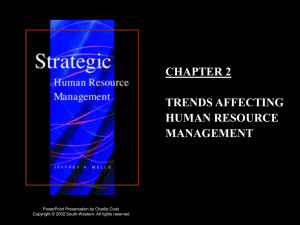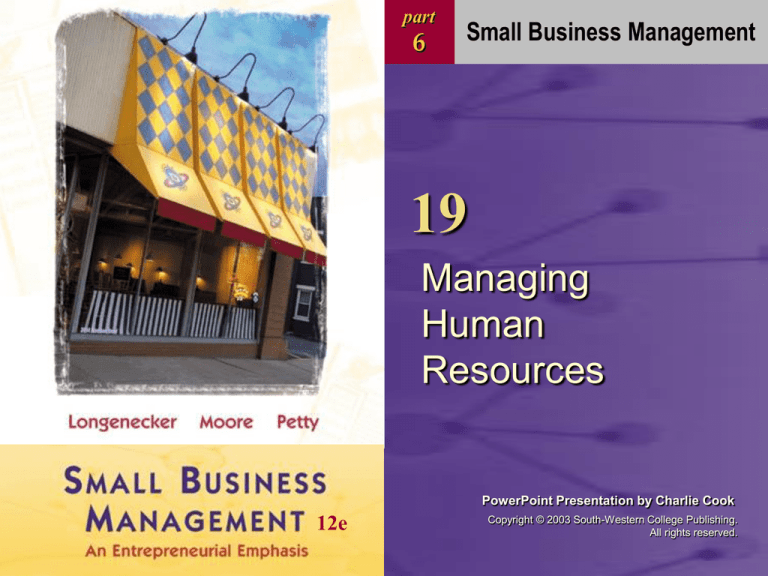
part
6
Small Business Management
19
Managing
Human
Resources
PowerPoint Presentation by Charlie Cook
12e
Copyright © 2003 South-Western College Publishing.
All rights reserved.
Looking Ahead
After studying this chapter, you should be able to:
1. Explain the importance of employee recruitment, and list
some sources that can be useful in finding suitable
applicants.
2. Identify the steps to take in evaluating job applicants.
3. Describe the role of training for both managerial and
nonmanagerial employees in a small firm.
4. Explain the various types of compensation plans including
the use of incentive plans.
5. Discuss the human resource issues of employee leasing,
legal protection, labor unions, and the formalizing of
employer–employee relationships.
Copyright © by South-Western College Publishing. All rights reserved.
19–2
Recruiting Personnel
• The Need for Quality Employees
–Employee performance affects the capability of
the firm to service customer needs.
–Employee performance affects profitability.
–Payroll costs affect firm’s bottom line.
–Quality of employees determines the long-term
competitive potential of the firm.
Copyright © by South-Western College Publishing. All rights reserved.
19–3
The Lure of Small Firms
• Advantages of Employment in Small Firms
–Quicker movement to decision-making levels of
management
–Greater managerial freedom
–More opportunities for broad-based managerial
experience
–Flexibility in work scheduling
and job sharing
Copyright © by South-Western College Publishing. All rights reserved.
19–4
Sources of Employees
Sources of Employees
Walk-ins
Executive Search
Firms
Internet
Recruiting
Schools
Employee Referrals
Help-Wanted
Advertising
Public Employment
Agencies
Private Employment
Agencies
Temporary Help
Agencies
Copyright © by South-Western College Publishing. All rights reserved.
19–5
Diversity in the Workforce
• Workforce Diversity
–Differences among employees in terms of such
dimensions as gender, age, and race.
–Diversity is increasing with higher proportions of
women, older workers, and racial minorities
entering the workforce.
Copyright © by South-Western College Publishing. All rights reserved.
19–6
Job Description
• Job Description
–A written summary of the essential duties required
by a specific job
Aids in personnel recruitment.
Helps focus employees on their work.
Provides direction in training.
Serves as the basis for performance review.
• Job Specification
–A list of the skills and abilities needed by the job
holder to successfully perform a specific job
Aids in selecting the most qualified job applicant.
Copyright © by South-Western College Publishing. All rights reserved.
19–7
Job Description for a Stock Clerk in Retail Food Store
Title: Stock Clerk
Primary Function: To stock shelves food products and other items
Supervision Received: Works under direct supervision of store manager
Supervision Exercised: None
Duties:
1. Receive and store products in storage area.
2. Take products from storage, open outer wrapping, and place on store
shelves.
3. Provide information and/or directions to customers seeking particular
products or having other questions.
4. Monitor quantity of products on shelves and add products when supplies
are low.
5. Perform housekeeping duties when special need arises—for example,
when a container is broken or products fall on the floor.
6. Assist cashiers in bagging products as needed during rush periods.
7. Assist in other areas or perform special assignments as directed by the
store manager.
Figure 19.1
Copyright © by South-Western College Publishing. All rights reserved.
19–8
Evaluating Prospects and Selecting Employees
Steps in Recruiting Employees
Application Forms
Applicant interview
Reference checking
Applicant testing
Physical Examination
Copyright © by South-Western College Publishing. All rights reserved.
19–9
Training and Developing Employees
• Purposes of Training and Development
–Prepare recruit to perform the duties of the job.
–Improve the performance of current employees.
–Prepare employees for career advancement.
–Improve morale of current employees.
–Serve as an inducement to potential applicants.
• Factors in Establishing a Training Program
–Determining the need for training
–Creating a plan for training
–Setting a timetable for training
–Providing employee counseling
Copyright © by South-Western College Publishing. All rights reserved.
19–10
Types of Training and Development
Orientation of
New Personnel
Development of
Managers and
Professionals
Training
and
Development
Training to
Improve Quality
Training of
Nonmanagerial
Employees
Copyright © by South-Western College Publishing. All rights reserved.
19–11
PREPARE EMPLOYEES
Steps in Job
Instruction
• Put employees at ease.
• Place them in appropriate jobs.
• Find out what they know.
• Get them interested in learning.
PRESENT THE OPERATIONS
• Tell, show, and illustrate the task.
• Stress key points.
• Instruct clearly and completely.
TRY OUT PERFORMANCE
• Have employees perform the task.
• Have them tell, show, and explain.
• Ask employees questions and
correct any errors.
FOLLOW UP
• Check on employees frequently.
• Tell them how to obtain help.
• Encourage questions.
Figure 19.2
Copyright © by South-Western College Publishing. All rights reserved.
19–12
Compensation and Incentives for Small
Business Employees
• Financial Incentives
–Keys to developing an effective bonus plan:
Set attainable goals.
Set meaningful goals.
Bring workers in
(employee participation).
Keep targets moving.
Aim carefully.
Copyright © by South-Western College Publishing. All rights reserved.
19–13
Compensation and Incentives for Small
Business Employees (cont’d)
• Fringe Benefits
–Supplements to compensation designed to be
attractive and beneficial to employees.
Benefits are a substantial portion of payroll costs.
Small firms tend to provide fewer benefits.
Small firms are increasingly outsourcing the
administration of their benefits programs.
Copyright © by South-Western College Publishing. All rights reserved.
19–14
Employee Stock Ownership Plans
• Employee Stock Ownership Plans (ESOPs)
–Plans through which a firm is sold either in part or
in total to its employees.
Employees’ performance is motivated by their sharing of
ownership in the firm.
Owners can cash out and withdraw without selling to
outsiders.
ESOPs offer tax advantages to owners and employees.
Copyright © by South-Western College Publishing. All rights reserved.
19–15
Special Issues in HRM
• Employee Leasing
–The “renting” of personnel from an organization
that handles paperwork and administers benefits
for those employees
Leasing allows small firms to provide employee benefits.
Leasing makes small firms subject to additional
government regulations.
–Professional Employment Organization
A personnel-leasing company that places employees on
its own payroll and then “rents” them to employers on a
permanent basis.
Copyright © by South-Western College Publishing. All rights reserved.
19–16
What Employee-Leasing Companies
Offer to Small Firms
• Better health insurance
• Preparation of paychecks
• Payment of payroll taxes
• Analysis of government regulations
• Preparation of government reports
• Monitoring of vacation and sick days
Copyright © by South-Western College Publishing. All rights reserved.
19–17
Special Issues in HRM (cont’d)
• Legal Protection of Employees
–Civil Rights Act (1964)
Legislation prohibiting discrimination based on race,
color, religion, sex, or national origin.
Applies to all employers of more than 15 people.
–Americans with Disabilities Act (1990)
Legislation prohibiting discrimination against persons
with disabilities; requires “reasonable accommodation”
by firms in the employment of disabled persons.
Copyright © by South-Western College Publishing. All rights reserved.
19–18
Special Issues in HRM (cont’d)
• Legal Protection of Employees (cont’d)
–Sexual harassment policy guidelines
Establish clear and meaningful policies regarding sexual
harassment in the workplace.
Meet with employees and supervisory personnel to
discuss the policies.
Investigate any and all complaints of sexual harassment
fairly and thoroughly.
Take timely and appropriate action against all violators.
Copyright © by South-Western College Publishing. All rights reserved.
19–19
Special Issues in HRM (cont’d)
• Legal Protection of Employees (cont’d)
–Occupational Safety and Health Act (1970)
Legislation that regulates the safety of workplaces and
work practices.
Created the Occupational Safety and Health
Administration (OSHA) to establish and enforce health
and safety standards.
–Fair Labor Standards Act
Federal law that establishes a minimum wage and
provides for overtime pay for more than 40 hours per
week.
Copyright © by South-Western College Publishing. All rights reserved.
19–20
Special Issues in HRM (cont’d)
• Legal Protection of Employees (cont’d)
–Family and Medical Leave Act (1993)
Legislation requiring firms to provide employees with up
to 12 weeks of unpaid leave for childbirth and other
family needs.
Requires firms to continue health-care coverage during
the leave and guarantee that the employee can return to
the same or a comparable job.
Copyright © by South-Western College Publishing. All rights reserved.
19–21
Special Issues in HRM (cont’d)
• Formalizing of Employer-Employee
Relationships
–Employee handbook contents
Expression of company philosophy
Recruitment
Selection
Training
Vacations
Grievances
Discipline
Performance reviews
Copyright © by South-Western College Publishing. All rights reserved.
19–22
Special Issues in HRM (cont’d)
• The Need for a Human Resource Manager
–Conditions favoring the appointment of an HR
manager:
A substantial number of employees (100+)
Unionized employees
A high labor turnover rate
A strong need to recruit skilled and professional
employees
Supervisors or operative employees in need of training
Low employee morale
Intense job market competition for personnel
Copyright © by South-Western College Publishing. All rights reserved.
19–23

